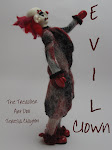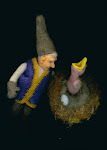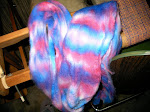I've just spent a couple of hours fussing over my silkworms. The world's only domesticated insect certainly can be high-maintenance. But, it will be worth it when I have all that lucious Bombyx Silk right? Right?!!
*
Why are Bombyx silkworms considered a domesticated insect? Because, you will not find them in nature, ever. Now, there are all kinds of other worms out there from tent worms to Tussah worms but, Bombyx Mori are totally and completely domesticated. What I am raising here is where fine silk comes from. (I mention this only because as I meander about on the internet I see that there are many misconceptions out there, people who believe their trees are being "infested by silkworms".)
*
If I knew there would be a plentiful supply of mulberry leaves available to me over the next several weeks my job as caretaker would be decidedly easier. You can get a silkworm to switch from the mulberry chow diet to fresh mulberry leaves but, it is quite a trick to get a silkworm to switch from the fresh leaves to the mulberry chow. So, rather than spoil the little dears and make them all finicky and then have a hard frost destroy the only food they'd be willing to eat, I've simply been feeding the mulberry chow. This makes for a bit more work with clean up and and feeding time.
Above you can see the mulberry chow as it is drying out. The silkworms do not drink and must obtain the water they need from their food supply. Today I carefully replaced the drying food with fresh mulberry chow just like I did yesterday, etc., etc. This picture is interesting because you can see the fine layer of silk that is on the drying mulberry chow. The worms are constantly throwing down a layer of silk. They entwine themselves with the old food and each other and they're very fragile so I'm finding myself really fussing over the feeding and cleaning process.
*
Were I to be feeding fresh mulberry leaves I could lay a net over the worms and gently layer new leaves above the netting. The silkworms would crawl up through the holes of the netting to get to the fresh leaves then I could just lift the netting with the worms and the new leaves all together and clean out beneath them. That process is called "netting up". The mulberry chow is dense and heavier and so I fuss about with a paintbrush lifting worms from drying chow to fresh, moist chow...
Here you can see they are enjoying a breakfast of fresh chow. The silkworms are officially 8-10 days old now. You will note that they are growing fast and furiously compared to just a little over 1 week ago.
And, as Claxton has not had a single solitary paternal instinct kick in I'm definitely on my own with these little angels who will soon need to be fed fresh chow several times a day. I may have to knit a special carrying pouch and take them with me everywhere I go. And, as much as I want these little guys to thrive I don't want to risk being known as "the worm lady". I need a Mary Poppins-type to come help me. She can make a musical adventure out of feeding them their mulberry mash while I go about my other business.
*
And I do have other business because I made another cotton cloth pattern. It shall be posted forthwith which likely means sometime next week as I have to squeeze my knitting time in between these fussy, fussy feedings.































2 comments:
I just read a book in which the grandmother ran a silk worm farm.
How cool to see the little buggers!
Wow -- way cool info! I always wondered how this worked for the average silkworm caretaker!
Post a Comment